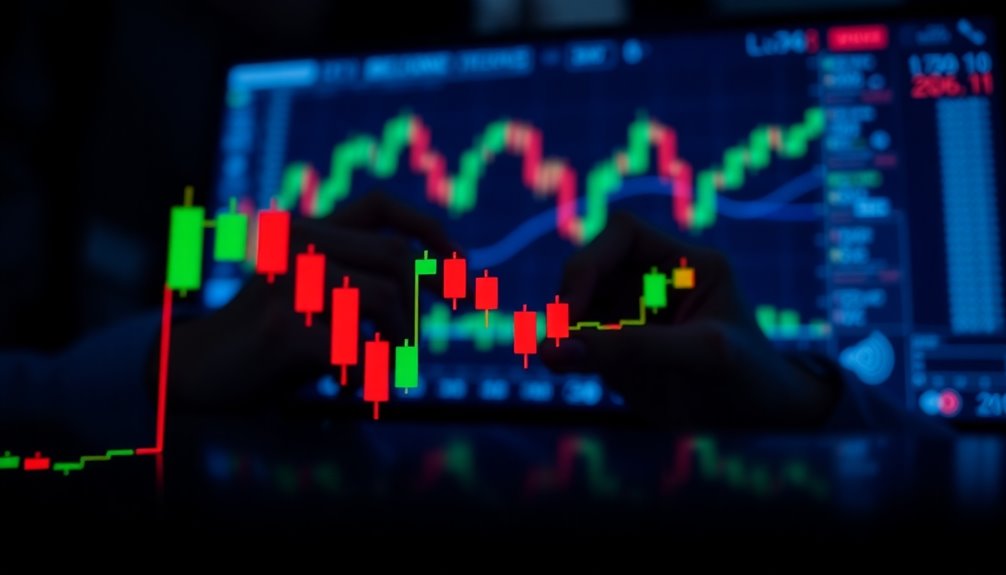Carry trade is a strategy where you borrow in a currency with low interest rates and invest in one with higher rates. By exploiting the interest rate differential, you can potentially earn returns between 5% and 6% annually. It's essential to keep an eye on central bank policies, as they greatly influence interest rates. However, this approach carries risks, especially due to currency fluctuations that can impact your profits. Understanding market dynamics can help you navigate these risks effectively. There's much more to discover about the nuances and strategies involved in carry trading.
Key Takeaways
- Carry trade involves borrowing in low-interest currencies and investing in higher-interest currencies to profit from the interest rate differential.
- It capitalizes on differences in interest rates between countries, leading to potential substantial returns.
- Currency risk is a significant concern, as exchange rate fluctuations can impact profitability.
- Market dynamics, including central bank policies and geopolitical events, can rapidly influence carry trade outcomes.
- Emerging market carry trades are increasingly popular, offering higher yields but also greater risks.
Interest Rate Differential Strategy

When you engage in carry trading, the interest rate differential strategy is key to maximizing your profits. In this investment strategy, you borrow in a currency with low interest rates and invest in one offering higher interest rates.
For example, you could borrow Japanese yen at 0.1% and invest in U.S. dollars yielding 5.5%, allowing you to profit from the difference of 5.4%.
It's crucial to monitor central bank policies, as changes in interest rates can significantly impact your returns. The currency markets can shift rapidly, especially with potential rate hikes like those from the Bank of Japan.
Market Dynamics Overview

Understanding market dynamics is crucial for anyone involved in carry trading, as shifts in global capital flows and exchange rates can significantly impact your investment outcomes.
Trade activity often hinges on interest rates, with variations leading to changes in currency attractiveness. As you devise your investment strategies, remember that economic growth influences currency values and can create opportunities or risks.
Central banks play a vital role, adjusting interest rates that can alter the landscape for carry traders. Moreover, geopolitical events can affect investor confidence, leading to rapid changes in the global financial environment.
Effective risk management becomes essential to navigate these complexities, ensuring you're prepared for the unpredictability inherent in carry trading. Stay informed to maximize your potential returns.
Interest Rate Gap Exploitation

Market dynamics create a fertile ground for exploiting interest rate gaps in carry trading. By borrowing in low-interest currencies like the yen, you can invest in currencies with higher rates, such as the US dollar.
This strategy capitalizes on the interest rate differential, often yielding annual returns of 5% to 6% on dollar-yen carry trades. However, the economic landscape can shift quickly; even minor rate changes can significantly affect your profits.
For instance, the 2024 interest rate hike by the Bank of Japan from nearly zero to 0.25% caused a swift unwinding of yen carry trades. Understanding these fluctuations in financial markets is crucial, as they reveal opportunities to exploit exchange rate anomalies for better investment returns.
Benefits and Drawbacks

While carry trading can be an enticing strategy for generating profits through interest rate differentials, it's essential to weigh its benefits against the inherent risks.
You might enjoy substantial returns by borrowing at low rates, but currency risk looms large, as exchange rate fluctuations can quickly erode profit margins.
Market volatility also plays a role; historical events show that rapid unwinding of carry trades can trigger global market disruption.
Moreover, psychological factors, like overconfidence and herd behavior, can lead to impulsive decisions during turbulent times.
As you consider the carry trade, remember that while the potential for profit exists, the risks associated with interest rate shifts and market dynamics can significantly impact your outcomes.
Currency Pair Performance Analysis

When analyzing currency pair performance in carry trades, it's crucial to recognize how interest rate differentials shape your investment strategy. For instance, when an investor borrows in the Japanese yen, they can capitalize on the spread between Japan's near-zero rates and higher rates elsewhere, like U.S. Treasury yields.
During stable economic times, pairs like AUD/USD and NZD/USD thrive, offering attractive returns due to elevated interest rates in those regions. However, beware of market volatility; if the Japanese yen appreciates sharply, it can erode your interest rate advantage.
Additionally, central bank decisions and inflation reports significantly influence which currency pairs are most appealing, especially in a fluctuating global economy or during a financial crisis.
Market Volatility Impact

Understanding the impact of volatility on carry trades is essential for navigating the complexities of the forex market. Carry trades can amplify market volatility, especially during times of economic stress.
When positions suddenly unwind, you might witness rapid sell-offs and significant swings in asset prices. Historical events, like the 2008 financial crisis and the recent August 2024 Japanese stock market collapse, illustrate this correlation.
For instance, the Japanese yen appreciated by 13% against major currencies after the Bank of Japan's interest rate hike, showcasing how currency fluctuations can affect carry trade profitability.
Additionally, anticipated narrowing of interest rate differentials can signal shifts in carry trade activities, which further influences market sentiment and volatility, impacting broader financial markets.
Emerging Market Carry Trade Trends

As investors search for higher yields, emerging market carry trades have become increasingly attractive, allowing you to borrow in developed market currencies with low interest rates and invest in local currencies that offer returns often exceeding 7% annually.
In 2023, countries like Brazil and South Africa gained prominence due to their favorable interest rate differential.
However, you should be cautious—currency fluctuations can significantly impact your returns, especially during geopolitical tensions or inflation concerns.
Institutional investors are driving capital flows into these emerging markets, but shifts in global monetary policy, such as changes from the U.S. Federal Reserve, can quickly alter the landscape, affecting the appeal of these trades.
Stay informed to navigate these trends effectively.
Leverage Low-Interest Currencies

By leveraging low-interest currencies, you can enhance your investment strategy and potentially boost your returns.
In carry trades, you borrow cheaply from low-interest currencies, like the Japanese yen, to invest in higher-yielding assets. For example, you might borrow at 0% in yen to fund purchases in U.S. assets yielding around 5.5%. This strategy capitalizes on interest rate differentials, amplifying potential gains through leverage.
However, be cautious of currency volatility, as unexpected changes in rates can increase your risk. It's essential to monitor economic data and geopolitical factors closely, as these shifts can significantly impact the profitability of your leveraged carry trades.
Stay informed to navigate the complexities of this investment approach effectively.
Frequently Asked Questions
What Is Meant by Carry Trade?
When you hear about carry trade, think of an investment strategy where you borrow money in a currency with low interest rates to invest in assets that offer higher returns.
You aim to profit from the difference in interest rates. This approach can apply to various investments, but you need to be aware of market sentiment and exchange rate changes, as they can impact your potential gains significantly.
What Is Carrying on Trade?
Carrying on trade involves the logistics and movement of goods between countries.
You coordinate shipping, trucking, and air freight to ensure products reach their destination efficiently. This process affects not just delivery times but also costs, which can impact your pricing and inventory management.
You'll need to consider factors like infrastructure quality and regulations that can influence how smoothly your trade operations run.
Ultimately, it's key for your business's success in international markets.
What Is Carrying Trade History?
Imagine you're a sailor navigating a sea of currencies.
The history of carry trade is like your ship's journey, starting in the early 2000s with the calm waters of low Japanese yen rates.
As you sail further, you encounter storms, like the 2008 financial crisis, pushing you toward riskier shores.
Yet, beware the tides; when markets shift unexpectedly, your ship might capsize, just as it did in August 2024 with the Nikkei's steep decline.
What Is Trade Carried?
When you think about trade carried, you're looking at how transactions are executed and maintained over time.
It involves managing the flow of goods and services, ensuring they reach the right destination efficiently.
You'll often focus on logistics, supply chain management, and the timing of deliveries.
This process can impact costs and overall satisfaction, so you'll want to pay attention to every detail to ensure smooth operations and successful outcomes.
Conclusion
In the world of finance, the carry trade is like a seesaw balancing risk and reward. By capitalizing on interest rate differentials, you can potentially reap significant benefits, but be wary of the pitfalls that come with market volatility. As you navigate this landscape, understanding currency pair performance and emerging trends will help you make informed decisions. Ultimately, staying vigilant can help you ride the waves of opportunity, ensuring you maximize your returns while minimizing risks.









